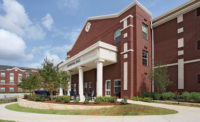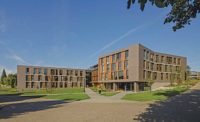Biola University Blackstone Residence Hall
La Mirada
BEST PROJECT, RESIDENTIAL/HOSPITALITY
Owner Biola University
Lead Designer Gensler
Contractor Millie and Severson Inc.
Civil Engineer Sessions Consulting Engineers
Structural Engineer Saiful Bouquet
MEP Engineer TK1SC
Landscape Architect Takahashi Associates
Consultant Webb Food Service Design
Constructed on the last available parcel of campus land, the Blackstone Residence Hall was squeezed between a major college entrance, a busy street and two existing structures, with no green space on the site. To make the design work, the project team employed the latest building information modeling and document-control technologies to create an angular building design that maximizes the number of units while leaving room for outdoor amenities.
The result is an efficient LEED Gold building, highlighted by smaller-than-average, 150-sq-ft dorm rooms. The saved area was allocated for more commons space, study alcoves, kitchens, terraces, a classroom and a café. The 61,000-sq-ft structure provides 15% of its area as amenity space for residents. It also created a new secondary campus entrance.
The unique design also was economical. The team estimates the cost per bed to be 22% lower than the national average, meeting the university’s target to offer lower-cost housing without the use of wood framing.
Optimizing the design for cost, schedule and quality, the 350-bed residence hall uses a load-bearing, stud-wall frame system with a concrete-topped metal deck that spans wall to wall. As a result, there are virtually no beams throughout the dorm areas. This resulted in a lower floor-to-floor height, faster erection and superior longevity compared with typical wood-framed construction.
To achieve LEED Gold, the project utilizes sustainable building systems such as active and passive controls to manage energy use; motion-sensor lights in all spaces; special triggers to disable HVAC use when the operable windows are open; solar fins that shade west-facing windows for additional energy savings; and geopier footings in place of typical cast-in-place concrete, which saved time and money.







Post a comment to this article
Report Abusive Comment